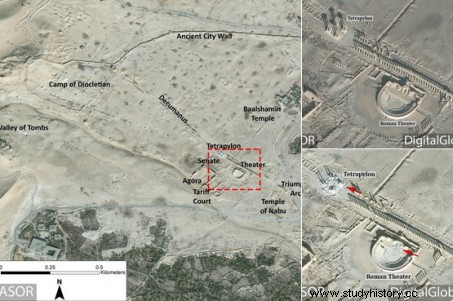Daesh, the Islamic State terrorist group, has destroyed new archaeological treasures in Palmyra, Syria.

The Tetrapylon monument, as it could be seen in the archaeological site of Palmyra (Syria), is now partially destroyed.
Palmyra. Further destruction is to be deplored in Palmyra, Syria. According to the American School of Oriental Research (ASOR), which obtained images from DigitalGlobe, an operator of Earth observation satellites, further destruction has been reported at the site of the ancient World Heritage-listed city of Unesco. These photos show significant damage to the Tetrapyle, as well as inside the Roman amphitheater. Of the first monument of 16 columns erected under Diocletian (3rd century), only four columns would still be standing. The Tetrapylon of Palmyra (also known as the tetrakonion) consisted of 4 pylons, themselves formed of four columns each. Only one in pink granite from Aswan (Egypt) was original. Inside the 2nd-century Roman theater, the destruction appears to have moved to the stage side, where you can clearly see in satellite images debris strewn around the structure.

Satellite image showing the location of new sites destroyed by Daesh between December 26, 2016 and January 10, 2017. Credit:ASOR/ Digital Globe

Global view of the archaeological site of Palmyra and the new destructions. Credit:ASOR/Digital Globe
Heinous crimes are also to be reported. Twelve people were reportedly executed within the grounds of the site as well as near the museum. Liberated in March 2016, the famous archaeological site and nearby town of Tadmor was again taken over by the Islamic State (IS) jihadist group in December 2016. By 2015, several other temples had already been annihilated.
